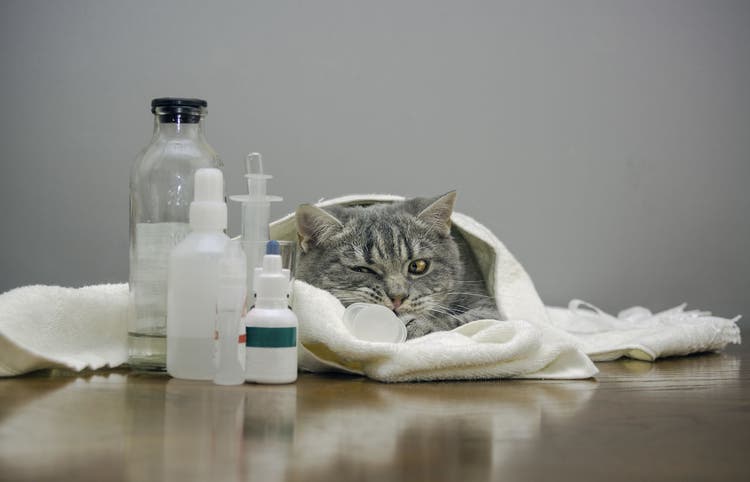
Ceftriaxone (Rocephin®) for Dogs and Cats
Overview of Ceftriaxone for Canines and Felines
- Ceftriaxone, also known as Rocephin®, is an injectable antibiotic used for dogs and cats. It can be further characterized as a third generation injectable cephalosporin used to treat serious infections, particularly those caused by susceptible strains of Enterobacteriaceae.
- Ceftriaxone’s bactericidal action is achieved through inhibition of mucopeptide synthesis in the bacterial cell wall: It has a high degree of stability in the presence of beta-lactamases, both penicillinases and cephalosporinases.
- Ceftriaxone is effective against both Gram-positive and Gram-negative bacteria. Gram-positive susceptibility includes certain Staphylococcal and Streptococcal organisms. Gram-negative susceptibility includes Bacteroides spp, Enterobacter spp. E. coli, Klebsiella spp, Proteus spp, Pseudomonas aerogenosa, and Serratia spp.
- Ceftriaxone is well absorbed following intramuscular injection and is widely distributed across organ systems. In addition, it crosses the blood-brain barrier and the blood-placenta barrier.
- Ceftriaxone is a prescription drug and can only be obtained from a veterinarian or by prescription from a veterinarian.
- This drug is not approved for use in animals by the Food and Drug Administration, but it is prescribed legally by veterinarians as an extra-label drug.
Brand Names and Other Names of Ceftriaxone
- This drug is registered for use in humans only.
- Human formulations: Rocephin® (Roche)
- Veterinary formulations: None
Uses of Ceftriaxone for Dogs and Cats
Ceftriaxone is used in both dogs and cats to treat a variety of bacterial infections, including:
- Respiratory tract infections
- Dermatological infections
- Urinary tract infections
- Bacterial septicemia
- Bone and joint infections
- Intra-abdominal infections
- Meningitis
- Ceftriaxone is not effective against infections caused by parasites (intestinal worms), mites, viruses, or fungi.
Precautions and Side Effects
- While generally safe and effective when prescribed by a veterinarian, ceftriaxone can cause side effects in some animals.
- Ceftriaxone should not be used in animals with known hypersensitivity or allergy to it or other cephalosporins. The most common hypersensitivity reaction in humans is the development of skin rash.
- Gastrointestinal side effects (vomiting and diarrhea) and pseudomembranous colitis may also occur following treatment with ceftriaxone.
- Blood values including ALT, AST, and BUN are sometimes increased in human patients receiving ceftriaxone and casts may appear in the urine.
- Concretions of the calcium salt of ceftriaxone have been found in the gallbladder of dogs treated with high doses of ceftriaxone.
- Eosinophilia, thrombocytosis, and leucopenia are the most common hematological side effects attributable to ceftriaxone.
- After intramuscular injection, local pain and sensitivity may be noticed and phlebitis may occur after intravenous administration.
Drug Interactions
- Ceftriaxone may interact with other medications. Consult with your veterinarian to determine if other drugs your pet is receiving could interact with cefoxitin. Such drugs include certain other antibiotics.
- Do not mix with other antimicrobial drugs because of possible incompatibility.
- Ceftriaxone should be used with caution in patients receiving loop diuretics as the risk of nephrotoxicity may be increased. Renal function should be monitored in such cases.
- Cephalosporins, in general, may interfere with Coombs’ test (false positives) and may falsely elevate urinary 17-ketosteroid values.
How Ceftriaxone Is Supplied
- Powder for Injection: Vials containing either 250 mg, 500 mg, 1 g, or 10 g.
- Injection:1 g or 2 g premixed, frozen. In 50 mL plastic containers.
Dosing Information of Ceftriaxone for Dogs and Cats
- Medication should never be administered without first consulting your veterinarian. If you’re concerned about costs related to medication, click here to learn how pet insurance may be able to help.
- In dogs, the usual dose is 7.5 to 25 mg per pound (15 to 50 mg/kg) every 12 to 24 hours intramuscularly or intravenously.
- In cats, the usual dose is 12.5 to 25 mg per pound (25 to 50 mg/kg) every 12 hours intramuscularly, intravenously, or intraosseously.
- After receiving ceftriaxone, many pets are sent home with a prescription of an oral cephalosporin, similar to ceftriaxone.
- The duration of administration depends on the condition being treated, response to the medication and the development of any adverse effects. Be certain to complete the prescription unless specifically directed by your veterinarian. Even if your pet feels better, the entire treatment plan should be completed to prevent relapse or prevent the development of resistance.